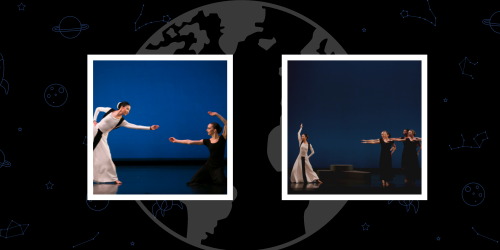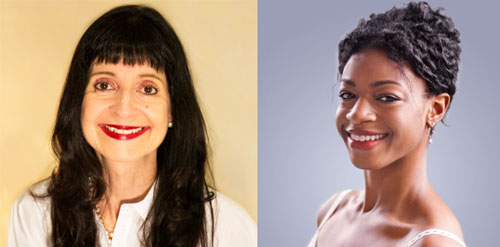This month, global audiences can screen Martha Graham’s Prelude to Action from Chronicle (curated by the Martha Graham Dance Company) on the Planet Classroom Network.
Chronicle premiered at the Guild Theater in New York City on December 20, 1936. The dance was a response to the menace of fascism in Europe at that time.
Leslie Andrea Williams received her BFA from The Juilliard School in May of 2015 and joined the Graham Company two months later. She performs featured roles in iconic Graham ballets such as the Woman in White in Diversion of Angels and the Pioneering Woman in Appalachian Spring. Her most notable role has been performing the Lead in Chronicle — the first black dancer to do that.
The Global Search for Education is pleased to welcome Leslie Andrea Williams.
Leslie, let’s begin by having you tell us in your own words what Chronicle is about and what audiences can expect in this Prelude to Action production.
Chronicle captures the different aspects of war — literally and figuratively. The first section, Spectre 1914, is an abstract personification of the many aspects of war and what it symbolizes. The second section is Steps in the Street, which to me is a very clear scene of women working to rebuild a town after it has been destroyed by a bombing while their husbands are off fighting in battle. And the final section, Prelude to Action, is a mix of both abstract and literal imagery. The women are ready to fight back and build a better future by working together. They use their intelligence, strength, and agility in ways they didn’t even know they could before. And the Woman in White is the character I play, who is leading the pack, but I also signify that beacon of hope and light that one can find in the depths of despair. So that’s what people can expect to see and feel when they watch Prelude…an overwhelming sense of hope and power.
Why is this work special in Graham’s vast portfolio – what makes it unique and special?
Chronicle is such a special piece and quite a crowd pleaser amongst our audiences! Before I joined the company, this was the first Graham piece I saw and it really resonated with me. It is special and unique because I don’t think there is any other piece like it that showcases a woman’s dance strength in this way. You watch the piece thinking, “Wow, these women are so strong!!” Or, “How do they do all that?”
And while the piece is about overcoming strife in war, it can also be about overcoming strife in any other capacity in all aspects of life. And everyone can relate to that.
Do you believe Graham’s work appeals to international audiences? What’s been your experience performing around the world?
Absolutely, Martha’s work appeals to international audiences! Her work is universal and timeless. She was very influenced by mythological stories that focus on the inner landscape, and she was inspired so deeply by other cultures. Her inspirations spanned from Mayan and Aztec civilizations all the way to Americana culture. I believe that wherever we tour, there is something for everyone. My experience performing around the world has been eye opening. I’d say that in places where the arts are more funded and supported by the government is where we get the most reception and enjoyment from the audience, and where we can perform some of Martha’s more abstract works. I’d say the countries with the most committed fans are usually in Europe and Asia – China, France, and the Netherlands, just to name a few!
What do you think keeps the Graham company young and vibrant?
Our company motto is “The first and the future.”
I think this motto encapsulates who we are trying to be as a company and what the dancers are capable of showcasing. While we still honor our almost 100 year history with performing Graham Classics from the distant past, we still are able to perform new works from up and coming choreographers and connect them to the old work. The messages are still the same in some strange way, which is why I believe Martha’s work is so timeless. Also the present group of dancers is so versatile. We are a younger company and most of us have different dance backgrounds than just coming up through the Graham school, so we are capable of working with many different choreographers in new styles. There was something about Martha’s work that spoke to us, so when people say that Martha Graham’s work is old-school and irrelevant, we say “think again!”
Lastly, what special skills or talent do you think a dancer must have to excel in the Graham technique?
The special skills or talents I believe a dancer should have to excel in the Graham technique is first and foremost a hunger for learning something over a long period of time. The Graham technique is not easy and requires patience, understanding, and awareness. One must understand the need to adjust and work on the body over time to execute the steps and exercises with more precision. Martha said, “It takes ten years to become a Graham dancer.” And while that may be an exaggeration to some degree, I think experiencing life and going through good and bad times helps with understanding the emotional aspect of the technique. Her work is based very heavily in imagery and character study, so the only way to tap into that is to live life! Also, Martha’s biography is called Blood Memory, which is a term interpreted as an instinctual understanding of life based on the knowledge passed down through our ancestors or our past.
Thank you Leslie!
C.M. Rubin and Leslie Andrea Williams
Don’t Miss Martha Graham’s Prelude to Action from Chronicle (curated by the Martha Graham Dance Company), now screening on the Planet Classroom Network.







Recent Comments